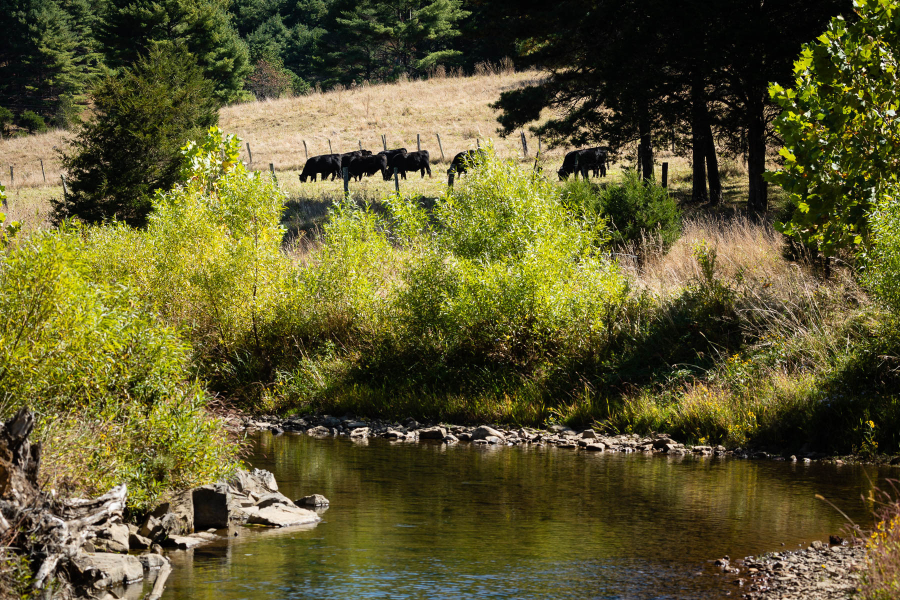Fencing out manure pollution

When thinking about the actions people can take to help keep the Chesapeake Bay and their local waterways clean, most people don’t think about—or don’t want to think about—livestock defecating into streams. Installing a fence around a waterway to keep livestock out is one of the more effective conservation practices that can help reduce pollution flowing into the water.
Agriculture is the single largest source of nutrient and sediment pollution entering the Chesapeake Bay, contributing 42% of nitrogen, 55% of phosphorus and 60% of sediment found in the water. The Environmental Protection Agency report, Guidance for Federal Land Management in the Chesapeake Bay Watershed provides estimates from the Chesapeake Bay Program’s suite of modeling tools that show manure accounts for 19% of nitrogen and 26% of phosphorus pollution reaching the Bay. The 2017 U.S. Department of Agriculture (USDA) Census of Agriculture notes there are approximately 6.1 million hooved livestock (e.g. cattle, pigs, horses, sheep) residing in the Chesapeake Bay watershed.
In 2019, the seven watershed jurisdictions—Delaware, the District of Columbia, Maryland, New York, Pennsylvania, Virginia and West Virginia—took a big step toward tackling this pollution as they completed their Phase III Watershed Implementation Plans (WIPs), which are strategies that outline the steps needed to meet pollutant reduction goals under the Chesapeake Bay Total Maximum Daily Load (Bay TMDL).
The jurisdictions all tackled the issue of agricultural pollution head-on in their WIPs, but the Commonwealth of Virginia had one unique idea in their plan to help keep livestock out of streams—requiring fencing by law if not voluntarily installed on properties throughout their portion of the watershed by December 31, 2025. To help landowners, Virginia’s Agricultural Cost Share Program would be revised to provide more flexible financial support and technical assistance to install fences.
Legislation was introduced in the 2020 General Assembly session that would put the above plan into place. One of the main arguments against the bill was that fencing—and the installation of an alternate watering system for livestock—would be costly for landowners, who may not have the resources to complete on their own.
On the other side, manure from livestock contains bacteria that makes water unsafe for swimming, bathing or drinking. Livestock waste also contains nitrogen and phosphorus pollution that fuels the growth of algae blooms that block sunlight from reaching underwater grasses, and when they decompose, rob the water of oxygen that plant and animal species need to survive, contributing to the Bay’s annual dead zone.
Streamside vegetation naturally helps to limit nutrient and sediment runoff, provide shade and stabilize streambanks. When livestock can access streams, they can trample those banks, as well as stream bottoms, contributing to erosion, increased water temperatures and additional sediment flowing into the water.
Livestock doesn’t just impact the water—the water can be detrimental to their health as well. Drinking stream water contaminated from their manure increases their risk of chronic toxicity, high iron, mineral deficiencies, lower overall weight and decreased milk production in lactating cows. Providing an alternate drinking system reduces instances of foot rot, bacterial inflammation, jaundice, fever, red nose, bovine virus diarrhea, tuberculosis and mastitis.
In the end, a compromise was struck, and the legislation passed in early February. The bill will apply to any person owning property on which 20 or more bovines are pastured and will continue to be a voluntary action until December 31, 2025. At that point, if Virginia’s Bay TMDL goals are not met, the Virginia Secretary of Natural Resources and the Virginia Secretary of Agriculture and Forestry must jointly determine if streamside fencing should become a requirement.
If you are interested in installing your own streamside fencing, please visit the USDA Natural Resources Conservation Service website to learn more about available technical assistance.

Comments
There are no comments.
Thank you!
Your comment has been received. Before it can be published, the comment will be reviewed by our team to ensure it adheres with our rules of engagement.
Back to recent stories